
Swim, not just float Driving innovation and new business models through Industry 4.0
15 minute read
10 June 2020
 Thomas M. Döbler United States
Thomas M. Döbler United States Brenna Sniderman United States
Brenna Sniderman United States- Monika Mahto India
 Claudia Ahrens United States
Claudia Ahrens United States
Disruptive change need not come at the expense of existing business models. With Industry 4.0 technologies, organizations can optimize current processes as well as develop new strategies with a focus on innovation.
Recent events related to the pandemic have resulted in significant shifts to the global economic environment. In situations like these, many companies may choose to stay put and try to protect their positions in the status quo. However, this approach can leave companies exposed to the risk of being disrupted, as those companies that are lagging in their digital journeys may be more likely to fall prey to competitive pressures. It thus more important now than ever before for companies to focus on innovation in existing/new products and services and build new business models to enable them to thrive in the fast-evolving economic environment.
The comfort zone temptation: More protection, less disruption
Industry 4.0 creates many opportunities for organizations to use advanced technologies across their entire value chains, driving operational excellence and business growth in multiple areas from products and services to supply chains and key stakeholders such as employees, partners, and customers.1 And yet, despite the opportunities Industry 4.0 technologies create for innovation, leaders continue to use these technologies to protect themselves from being disrupted by others, rather than to find new opportunities to disrupt their markets.
Learn more
Explore the Industry 4.0 collection
Learn about Deloitte’s services
Go straight to smart. Get the Deloitte Insights app
In a recent global study of C-level executives, 56 percent of leaders noted that they prioritize investments in Industry 4.0 to protect their organizations from disruption by competitors, while just 26 percent prioritize Industry 4.0 investments with an eye toward disrupting competition with new ways of doing business. Further, 40 percent—fewer than half of respondents—noted that their investments prioritize developing innovative and differentiated products and services that could generate new sources of revenue. We have seen this sort of pattern play out in other studies, where leaders have reported prioritizing protection against external disruption over actively disrupting their own existing business models by margins of two-to-one or more.2
40 percent of respondents noted that their investments prioritize developing innovative and differentiated products and services that could generate new sources of revenue.
But why should this happen, given the myriad transformational opportunities that Industry 4.0 and digital transformation can offer businesses? From a behavioral economics standpoint, this aversion to disruption makes at least some sense, as individuals are driven more by a desire to protect themselves from loss rather than to risk what they have by seeking something wholly new.3 However, focusing solely on protection may turn out to be the greater risk. In fact, companies that pursue and invest in innovation and disruptive capabilities may be the best positioned to grow in the long term. By focusing their efforts only on protection, leaders might be missing significant growth opportunities. In fact, research has shown that leaders who focus on innovation can see as much as a 22 percent increase in revenue and up to 19 percent increase in earnings before interest and taxes (EBIT).4
So how might leaders shift from a protective mindset to one that is more geared toward disruption—what we refer to as transformational innovation—and growth?5 Perhaps more specifically, how can leaders do this without feeling that they must sacrifice protection—while still realizing value and growth from their Industry 4.0 investments?
What is Industry 4.0? A brief description
The concept of Industry 4.0 incorporates and extends digital connectivity within the context of the physical world in digital enterprises, networks, and ecosystems. This drives the physical act of doing business across interaction, production, distribution, and performance, in an ongoing cycle known as the physical-to-digital-to-physical (PDP) loop (figure 1). Industry 4.0 technologies combine digital information from many different physical and digital sources, including the Internet of Things and analytics, additive manufacturing, robotics, high-performance computing, artificial intelligence and cognitive technologies, advanced materials, and augmented reality.
Throughout this cycle, real-time access to data and intelligence is driven by the continuous and cyclical flow of information and actions between the physical and digital worlds. Many organizations already have some portions of the PDP loop in place, namely the physical-to-digital and digital-to-digital processes. However, it is the leap from digital back to physical—from connected, digital technologies to action in the physical world—that constitutes the essence of Industry 4.0.6
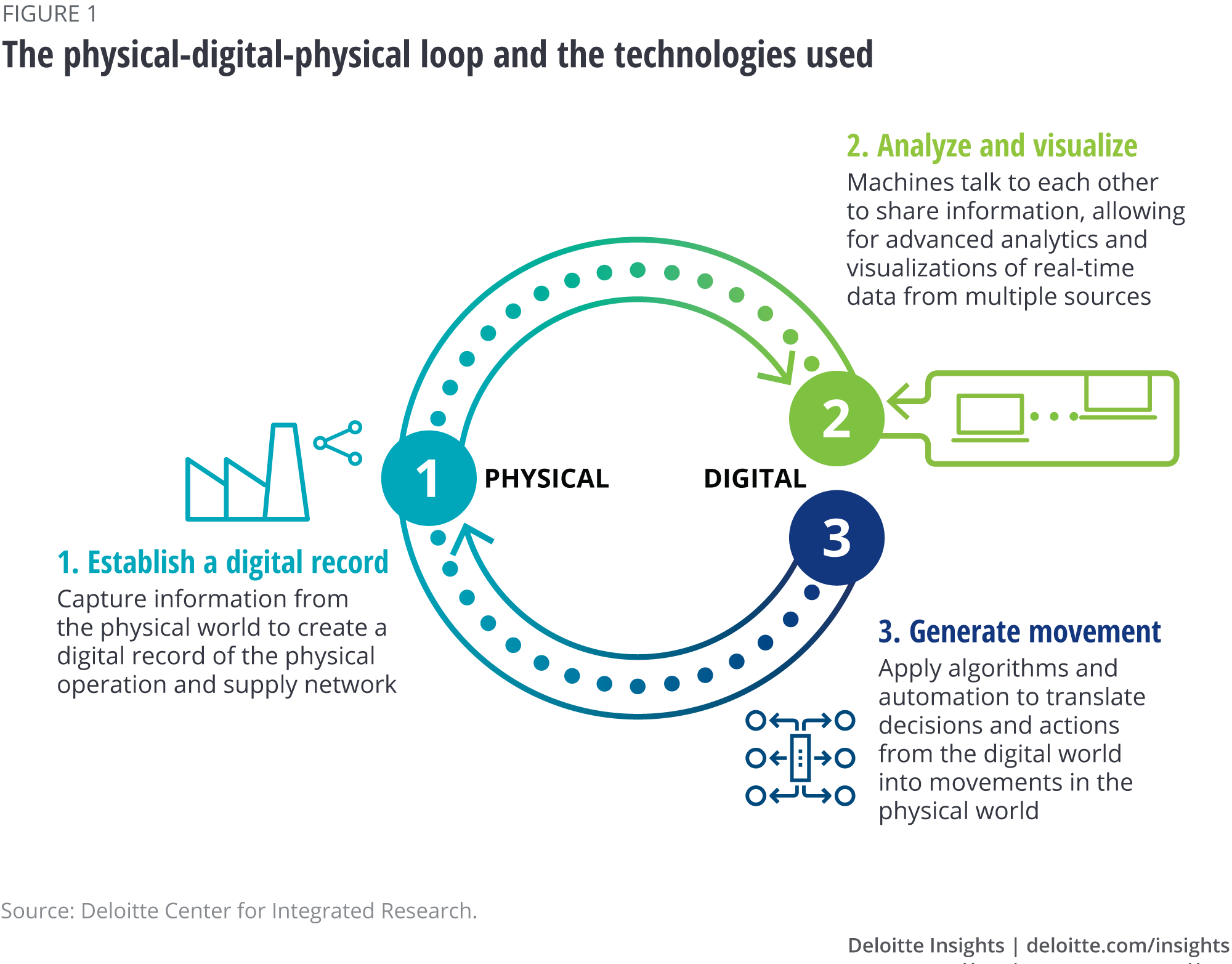
Defining it is the first step to doing it
Leveraging technology for protection involves using it to optimize existing processes—in other words, to do the same things better, faster, more safely, or more efficiently. Protection is often associated with defending or improving bottom lines through cost reduction and efficiency gains, and with operational excellence.
On the other hand, using technology for disruption involves doing something wholly new—either to drive new processes and recognize new efficiencies, to grow revenue by developing new or innovative products and services, or to drive new business models. Traditionally, disruption has meant a change that either upends an established market or industry or creates an entirely new one. Disruption can lead to established market leaders losing their dominance to new types of competitors that typically did not exist in their industry, or finding themselves up against companies from other industries as lines between industries grow more blurred.7
Both protection and disruption strategies can be valuable and critical for organizations—and they gradually scale up. To encapsulate the range of innovation organizations can explore and combine, it may therefore be more accurate, for the purposes of our analysis, to refer to “disruption” as strategic or transformational innovation.
Challenging the status quo: Applying transformational innovation in the organization
Monitoring and analyzing how leaders are investing in Industry 4.0 technologies and capabilities—and to what end—can help shed light on how their organizations are considering putting transformative technologies into practice. In a 2019 study of C-level executives’ perceptions of Industry 4.0, we asked respondents to choose a more critical immediate priority for their Industry 4.0 ̶ related investments: either protecting themselves or disrupting others. Two-thirds selected protection, while 33 percent selected disruption—a two-to-one margin.8 A 2020 study asked executives to select any number of priorities from a range of strategic Industry 4.0 investment focus areas but did not force a binary choice between the two extremes. In the updated study, more than half of leaders (56 percent) still prioritized investments in protection from being disrupted by others, while 26 percent prioritized investments in disruption—again, a roughly two-to-one margin.9
Research has shown that disruption can exist along a continuum of innovation, with some approaches more dramatic than others.10 The choice need not be solely between protection and full-on transformational strategies with nothing in between, and leaders can play in multiple areas across the innovation spectrum either singularly or simultaneously. For example, organizations can innovate by using technology to develop new, improved versions of current processes, products, or services. Alternatively, they can innovate in ways that lead to completely new products and services—or move into entirely new business models, companies, customers, or markets.11
Evidence exists that leaders are exploring those multiple innovation paths across a continuum of their products, services, and business models, as our recent global study of CxOs demonstrates (figure 2).
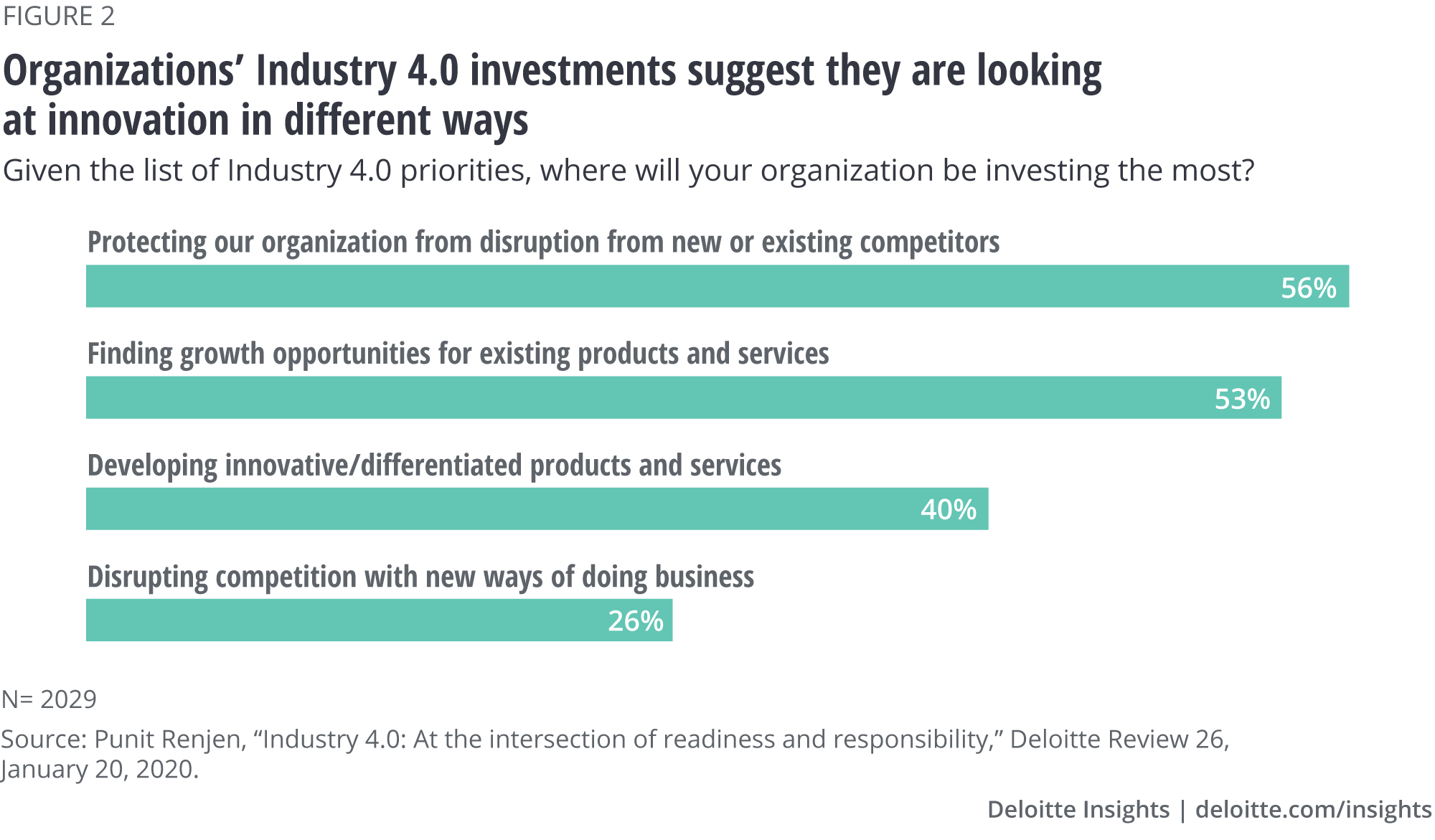
It’s all relative: Defining transformational innovation by industry
While most organizations realize the importance of embracing transformational innovation, it’s important to note that the notion of disruption is relative. Industries adopt technologies at different rates, build capabilities for different purposes, have varying appetites for experimentation and risk, approach technology investment and implementation differently, and face very distinct challenges; thus, what passes for protection in one industry may be seen as full-on transformation in another (figure 3). As an example, implementing blockchain in the financial services industry may not be considered transformational, but a manufacturer or a logistics provider may consider it as such. One such example of the latter is transport, logistics, and energy company Maersk launching an open global supply chain platform called TradeLens, in partnership with IBM. Based on blockchain technology, the platform evolves the supply chain network by enabling paperless international trade, which incorporates a greater degree of traceability, transparency, and efficiency into the process.12 This has enabled Maersk to move into a new area of service—ecosystem integrator—connecting organizations across the value chain.13
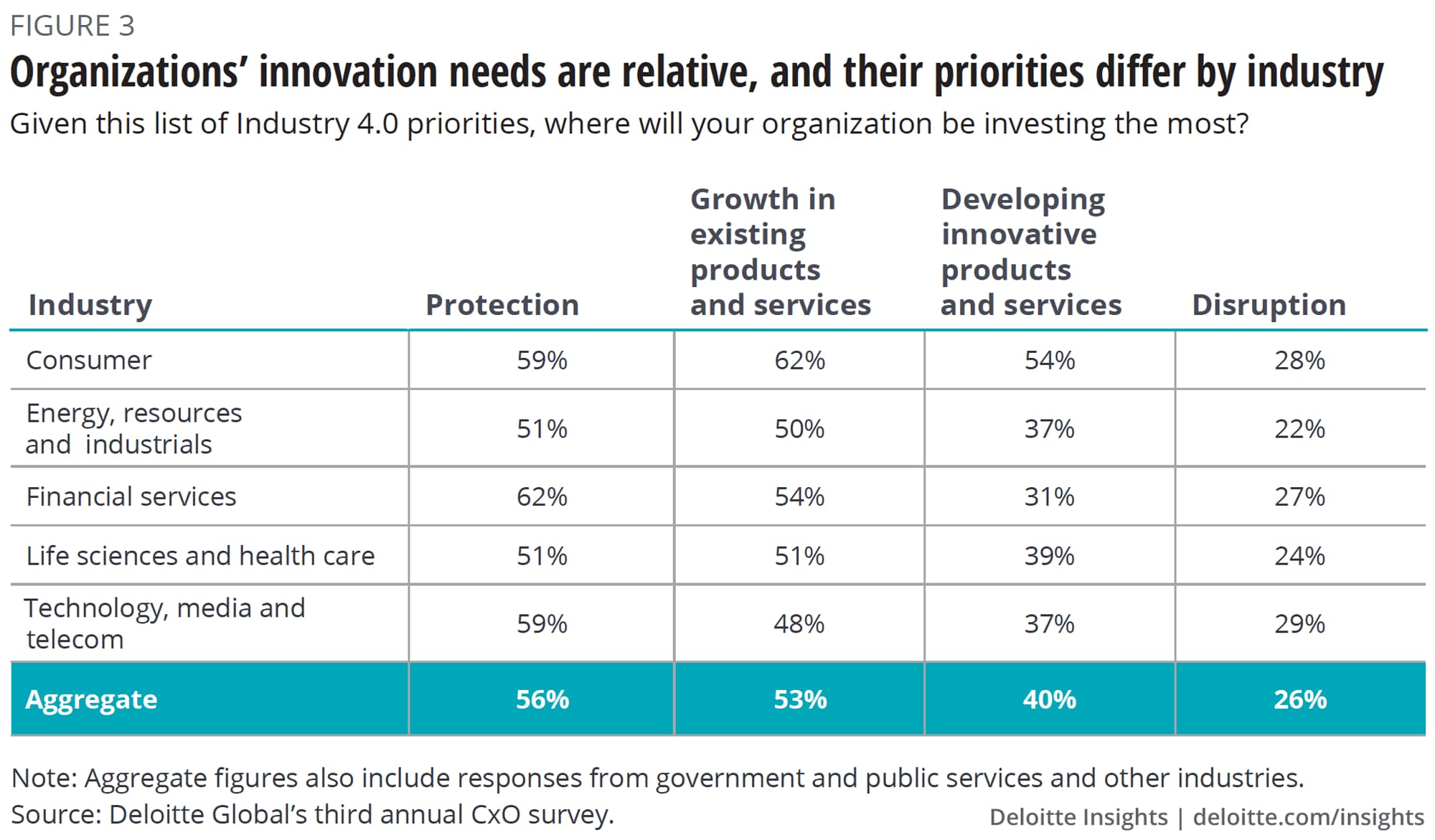
Why should companies want to move toward transformative innovation?
Deloitte’s research shows that, when done right, digital transformation has the potential to increase an organization’s revenue by up to 22 percent and EBIT by up to 19 percent.14 Further, organizations driven by innovation are nearly as likely to recognize significant return on investment (ROI) from transformative digital transformations as those that are driven by operational and production goals.15 Moreover, returns from investment focused on transformational innovation could be faster: Research shows that typically two years are enough to observe initial financial impacts, in terms of revenue and EBIT uplifts, from digital initiatives related to developing new products, services, and business models. At the same time, it could take up to five years to see the same results from more protective measures such as internal optimization.16
Given that the benefits of digital transformation seem obvious, what are the barriers preventing companies and leaders from pursuing transformative innovation? The answer involves multiple considerations: having the right strategic mindset, the right mix of people and culture, along with having a clear plan of action, including timing and focus of investments. These considerations include a more focused set of questions: Do leaders know what they want from technology, and do they have a clear strategy for what they are trying to achieve with it?
Research shows that typically two years are enough to observe initial financial impacts, from digital initiatives related to developing new products, services, and business models.
These questions are critical, and failure to answer them can lead to an unfocused approach—or worse, stagnation.17
What’s holding companies back? Identifying the challenges
As companies evaluate the transition from protective strategies toward transformational innovation, they are likely to encounter an array of multidimensional challenges, which are detailed below along with ways to manage them.
Choice overload
Behavioral studies suggest that people are more likely to invest for the future if they are presented with fewer, not more, investment options.18 The challenge of having too many technology choices and making technology decisions is even greater for organizations intending to disrupt the market through tech investments, because transformational innovation can require them to select unconventional approaches and technologies to achieve outcomes.19
Lack of vision and short-term thinking
Without a clear long-term vision, it is challenging to sift through all the choices, build a business case, and look beyond the short term to develop a longer-term plan that can enable truly transformational change but that may take longer to realize ROI. Moving from protective technology strategies to a more transformational innovation requires such a vision—while remaining grounded in today’s shorter-term needs. Quick and tangible benefits to the bottom line often get approval from the board, but they may not drive transformational, long-term growth. In other words, initial benefits can be seen relatively quickly in the medium term while fuller benefits in the form of higher ROI are likely to manifest in the long term.
Companies that truly aim to be more strategic (rather than protective) need to find the right ratio between low-hanging fruit and a more holistic, long-term strategic transformation effort that may take longer to manifest results. A long-term vision should also weather economic and business cycles. Indeed, companies best placed for disruption and strategic success stay invested for the long run and don’t lose sight of their strategic north star; rather than being impacted by business cycles, they maintain their focus on investing in what will bring more strategic impact in the long term, and perhaps leaving them better positioned for transformational growth. In fact, research suggests that companies that invest in key technological advances during downturns are better positioned to leapfrog competitors when economic conditions improve.20
Lack of a strategic plan
Having a strong long-term vision and clear outcomes can help organizations develop a robust plan for strategic innovation. Without a plan to turn that vision into action, it can be difficult for them to know where to invest in pursuit of a larger goal. The importance of a strategic plan isn’t limited to achieving transformational innovation, but also includes making progress on most Industry 4.0 priorities. In fact, research has shown that companies with comprehensive plans for Industry 4.0 are more likely to report achieving strong results, irrespective of the desired priorities—protection or disruption (figure 4). Further, clearly-stated goals are critically important; without them, it can be difficult, if not impossible, to evaluate what success looks like and whether it has been achieved.
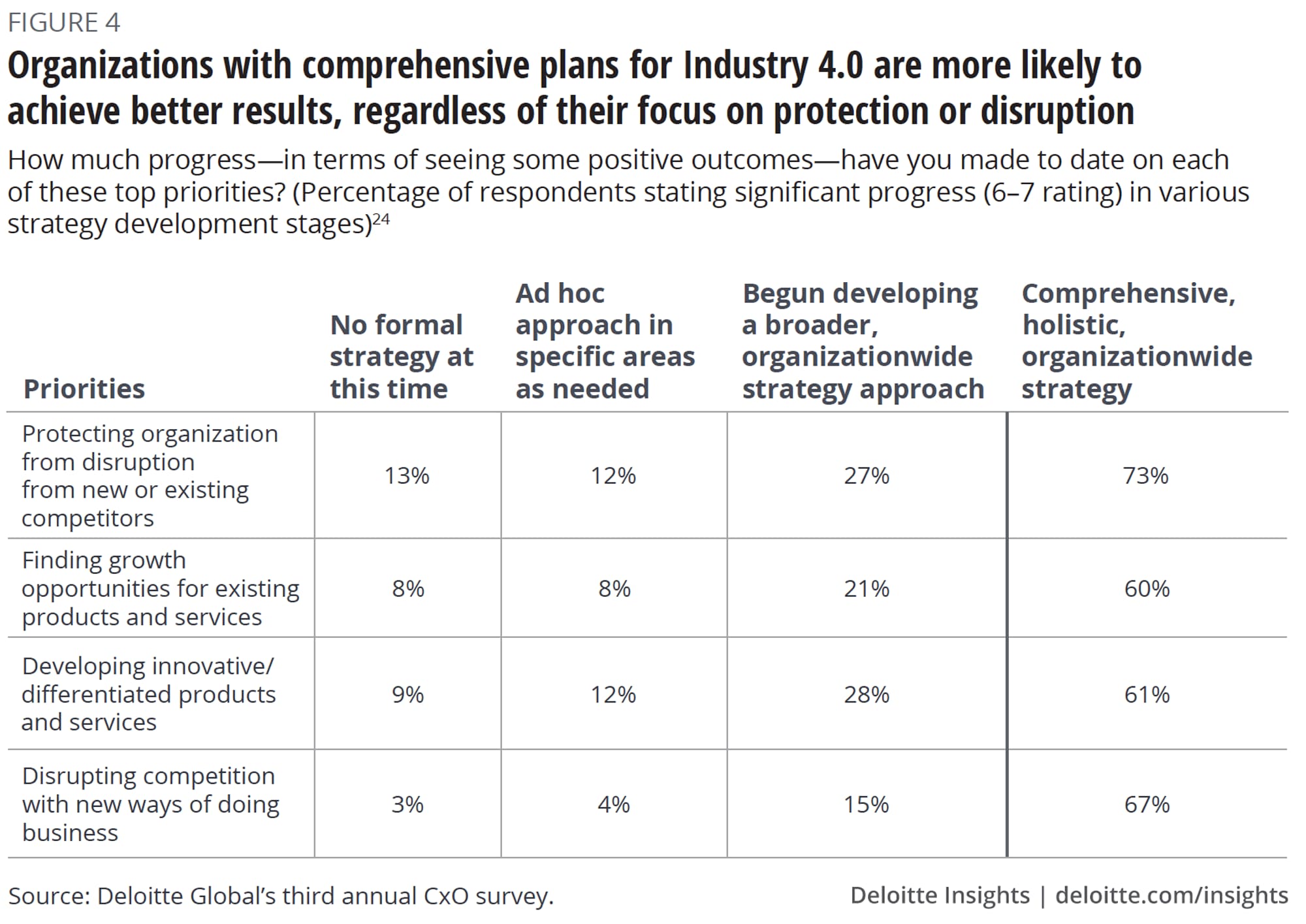
Lack of right talent and skills
Talent and training continue to be areas of ongoing focus for leaders, and consistently rate as a top concern and challenge with respect to navigating digital transformation. Seventy-four percent of leaders in a recent study noted that they prioritize Industry 4.0 investments for “training and developing a workforce with the skills needed to compete,” followed by 59 percent for “understanding what skills will be needed to compete effectively now and in the future.” While leaders are prioritizing talent development, they are still not confident about the effectiveness of their existing talent-related efforts: Only 21 percent say that they have made progress in understanding what skills will be needed to compete, and only 20 percent say that their organization possesses the skills they will need in the future.22 With that in mind, talent development appears to be an area of ongoing focus that requires concerted efforts, adaptation to ongoing changes, and a disruptive mindset to drive truly transformative efforts across the organization.
Lack of diverse perspectives
Research suggests that most organizations are not making decisions based on a diverse and inclusive set of perspectives and stakeholders—which means they are not necessarily living the “end-to-end visibility,” “fully connected” ethos of Industry 4.0: Four in 10 leaders do not strongly agree that their organizations have a culture of inclusivity that allows for diverse voices to be involved in top-level decision-making.23 This is a cultural issue that needs to be addressed to enable organizations to identify new opportunities and make fully informed and inclusive decisions. One way this can be achieved is through cross-functional teaming that promotes collaboration across multiple stakeholders within and outside the organization, to help create an organizationwide connective tissue.24
Getting started: Transitioning from operational excellence to transformational innovation
Digital transformation is a continuum and not an either-or between protection and disruption. Companies may start with leveraging advanced technologies for protection and process optimization, building a firm foundation of operational excellence and familiarity with technological capabilities, and gradually building upon those capabilities to push forward into growth and market disruption through new and innovative products, services, and business models. Or, rather than pursuing a sequential approach to transformative innovation, they may play in multiple spaces simultaneously, following a protective strategy in one area while pursuing transformational innovation in another. Indeed, companies don’t need to leave behind protection as they pursue innovation; instead, they can pursue multiple approaches to build a strategy that spans the three pillars of the organization: products and services; supply chain; and stakeholders such as customers, partners, or employees.25
So how do companies ensure a smooth transition from protection to transformational innovation? There are multiple strategic and operational pathways that companies can adopt to protect their margins, and eventually disrupt the competition (figure 5). Taking a holistic approach enables organizations to think across the many facets of innovation they can pursue, and mix “protection” with “disruption.”
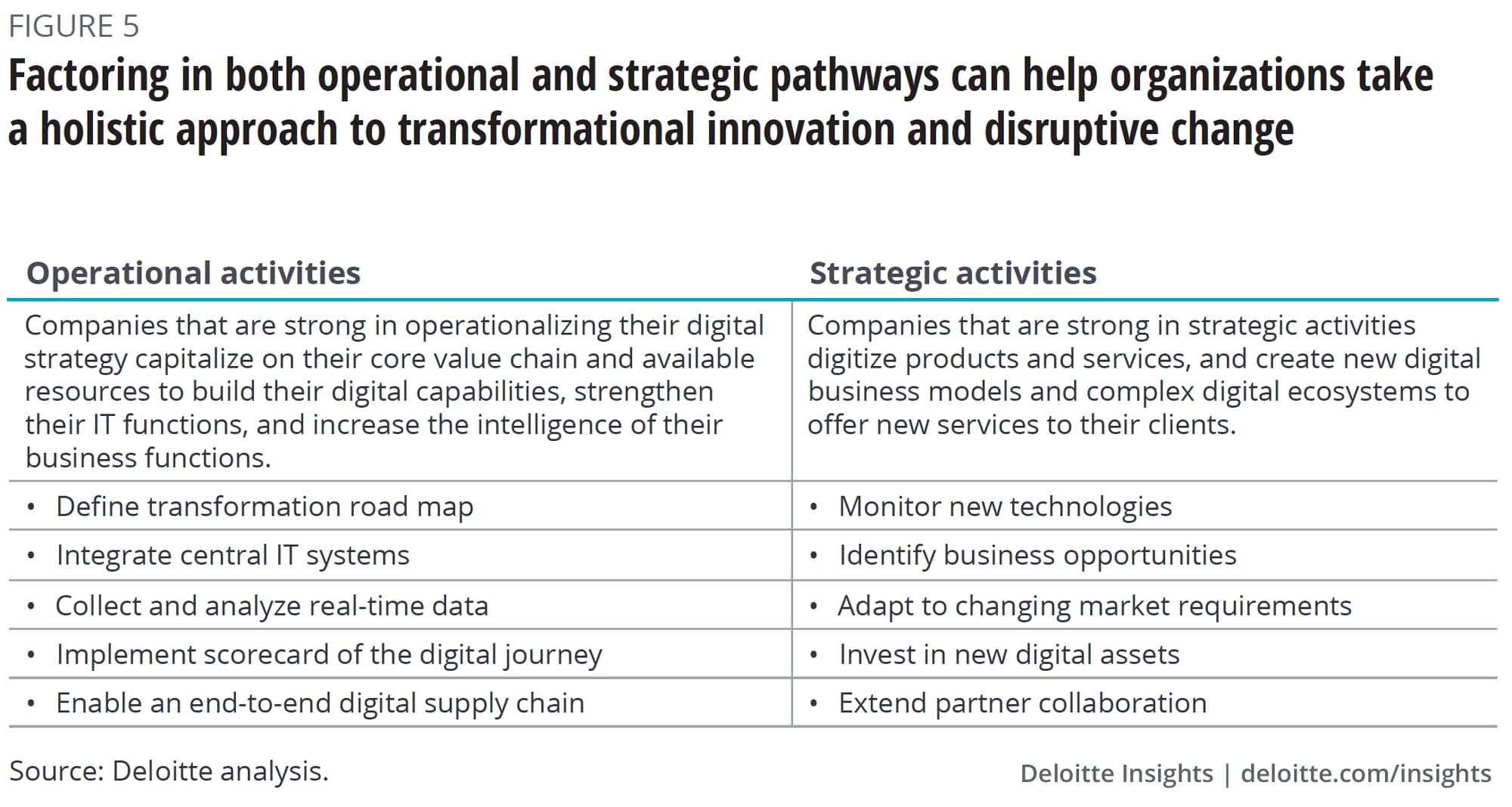
Operational activities drive the core of digital investments and tend to focus on streamlining and improving business processes, use of technology, and the flow of information to make organizations smarter about what they do—in other words, activities that might be classified as “protection” or, perhaps more accurately, an important foundational step toward a fuller transformation road map for innovation and growth. By focusing across the value chain, companies can ensure their digital and physical technology implementations can truly transform the way the organization operates and realize more significant benefits. A leading global manufacturer, for example, has leveraged digitization to establish end-to-end visibility across the supply chain, using sensors to enable a line of sight into inventory information. The program has helped the company optimize existing processes through lower costs, steadier gross margins, enabling existing inventory to address demand without increasing production and ultimately helping reduce more than US$250 million in inventory.26
As noted, operational activities can form the first step of a transformational road map that brings together technology, drives the creation of new data and information to make the organization smarter about what’s going on within its four walls and throughout the broader network, and connects the organization end to end throughout its value chain and network. Once this foundation has been laid, companies can use the data and information to not only make their business processes smarter, but also to identify new business opportunities—moving into more strategic innovation.
From a strategic perspective, leaders can pursue not only new technological capabilities to drive digital and physical connectivity but also use the resulting flows of data and information to identify new business opportunities, improve or build new products and services, and adapt more quickly to change. In one example, Merck has been leveraging advanced technology to develop modularized smart factories that will enable it to better and more quickly meet demand for smaller production runs across a broader array of medicines. The modules can be reconfigured as needed to adapt to production needs.27
This increased agility better enables companies to pursue those new opportunities and innovate more quickly. Ongoing monitoring of new technologies and investment in new digital assets build upon that foundation and allow organizations to keep developing their capabilities and evolving the ways in which they innovate. Further, thinking strategically and approaching innovation with a clear plan can help cut through choice overload challenges by enabling companies to make targeted technology investments that will connect the right dots. Finally, and perhaps most importantly, strategic pathways to transformational innovation also identify and leverage strengths that exist outside the organization in the broader ecosystem.
Leaders who can successfully drive transformational innovation are able to do so because they can optimize both strategic and operational approaches—increasing not only their revenue but also their EBIT. Focus on just innovation is effective, but only to a certain degree. Because this approach is not as holistic and may not incorporate the full value chain (including the supply chain), it does not necessarily harness the full power of productivity and operational gains. Likewise, a focus on process to the exclusion of products and services can create a strong value chain and improved productivity, but not innovation and revenue growth.
As companies start their journey along the pathway to transformational innovation and disruption, it is important to note that they shouldn’t feel impelled to move as quickly as possible. Research suggests that companies that start their digital transformation journeys later than their peers may actually be able to move to strategic disruption activities more quickly—whether by learning from the experiences of competitors, taking advantage of the rapid pace of technological innovation to invest in more advanced technologies and capabilities after they have had the chance to develop more fully, or putting together a deeply considered strategy.28
Lifesaver on? Time to swim
Industry 4.0 provides a spectrum of opportunities, each with differentiated value and complexity and with impacts along the value chain. Depending on the organization, its goals, or even its industry, the pathways to operational excellence, growth, and innovation may differ tremendously—but leaders have a real opportunity to create a holistic, transformational approach to leveraging Industry 4.0 capabilities to drive a smarter, more flexible organization.
Depending on the organization, its goals, or even its industry, the pathways to operational excellence, growth, and innovation may differ.
At the same time, however, companies still predominantly prioritize protection over disruption when making investments and executing their digital transformation efforts, leaving opportunities for more profound transformational change on the table. By shifting their mindset to recognize that the choice is not “either-or,” companies can build a firm foundation of operational excellence and technological infrastructure and capability that positions them to explore opportunities for innovation and transformational change.
The journey from protection to disruption brings with it its own set of challenges and considerations. Given the number of technology choices available to business leaders, a strategic approach to innovation and a clear vision on the path forward is critical. Organizations can consider making technology investments as part of a long-term approach that is dynamic and ongoing: Think about investments that will have a short-term ROI impact and operational activities, but that will also enable the organization to build toward its long-term, transformational vision.29 It is also essential for organizations to foster a culture of cross-functional teaming and use external partners throughout their ecosystem, harnessing the end-to-end possibility of Industry 4.0 across the network. By investing in innovation strategically, leaders can prepare for tomorrow without sacrificing their very real needs today.
© 2021. See Terms of Use for more information.
More from the Industry 4.0 collection
-
Ethical technology use in the Fourth Industrial Revolution Article5 years ago
-
Unlocking end-to-end digital fulfillment Article5 years ago
-
Radically transforming your support models Article5 years ago
-
Scaling up anything as-a-service Article5 years ago
-
Architecting an operating model Article5 years ago













